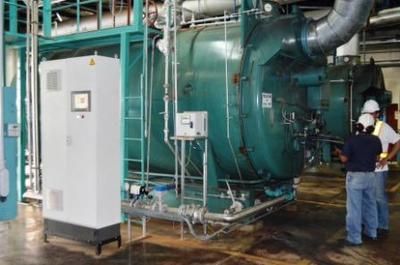COHRAL cleans up wastewater while harvesting green energy
Wednesday, 12 February, 2014
A cost-effective way to simultaneously increase the quality of wastewater produced by agribusiness while disposing of an expanding odour pollution issue is being deployed to assist crop and livestock operations achieve higher environmental standards.
The COHRAL technology of Global Water Engineering (GWE) involves a covered high-rate anaerobic lagoon that uses concentrated anaerobic bacteria to digest 70% of the organic matter (chemical oxygen demand, or COD) in wastewater to produce effluent of higher quality than open lagoons.
Even higher water quality standards - exceeding 90% COD removal and up to 99% in some instances - can be achieved by using GWE anaerobic and complementary technologies contained in totally enclosed tanks, or reactors, making it suitable for discharge in surface waters. This is according to the managing director of CST Wastewater Solutions, Michael Bambridge, whose company represents GWE technologies in Australasia.
COHRAL eliminates many of the odours associated with open lagoons often used in meat, dairy and crop waste processing. These are increasingly leading to environmental protests and land use conflict as urban expansion and rural businesses operate in greater proximity to each other, says Bambridge.
“Another major benefit of covered anaerobic lagoons and of totally enclosed anaerobic reactor systems is that the methane biogas produced within them by the anaerobic process can be collected and used to feed steam boilers and processing plant, replacing fossil fuel,” said Bambridge. Thus, closed lagoons not only prevent methane escaping into the atmosphere but also generate energy.

The first COHRAL installation in Australia, to be employed at a meat processing and packing plant, will feature re-use of the biogas in the boiler. The systems are suitable for solutions involving less technology-intensive applications that allow a long process residence time and where adequate space is available.
The anaerobic lagoons consist of two zones, with the complete surface of the lagoon being covered with an influent distribution system. The first and largest zone receives the major part of the incoming wastewater. This reaction zone is where the anaerobic digestion occurs.
The second, smaller part of the lagoon serves as a post-digestion and pre-settling zone where a partial clarification of the effluent wastewater takes place. Settled sludge collected in this zone is pumped back to the inlet of the lagoon.
Part of the anaerobic effluent is recycled back to the lagoon. The remaining effluent of the lagoon flows by gravity towards complementary technology, such as the GWE SuperSep-CFS separation technology being used in the Australian installation.
No additional mixing facilities are required in the anaerobic lagoon. The influent distribution system acts as a hydraulic mixing system, converting a standard low-load/low-efficiency lagoon into a COHRAL system with increased efficiency. Each lagoon is covered by a special floating membrane to retain the methane produced.
A typical feature of the system is the operation at zero biogas pressure (-1 to +1 mbar range). A sensitive membrane level measurement system controls the speed of a biogas extraction fan, bringing the gas at 20 mbar to go to the flare. Compared to ‘inflated’ single membrane covers, the risk for leaks is highly reduced.
A SCADA computer control system is typically employed with COHRAL technology. All indications and alarms, reporting on the daily operation of the plant and trending can be done via the system. All motor start/stop functions, as well as auto/manual, can also be controlled from the computer.
A simplified flow sheet can be displayed on the computer’s colour screen, featuring all measurements (continuously updated) and indicating operating motors. Alarms can be indicated by a colour change to red of the corresponding measurement or indication. An external acoustic alarm can also be incorporated.
Following the covering of lagoons and incorporation of anaerobic processes feed and recycle systems, CST Wastewater Solutions recommends the use of tanks to contain these processes. A third stage can be the incorporation of advanced anaerobic technologies into sealed tank environments, eg, GWE’s RAPTOR treatment system for organic residues.
Researchers trial magnetic resin to remove PFAS
A magnetic resin invented at The University of Queensland will be trialled at wastewater...
A sustainable approach to increase wastewater recycling
Flinders University research is investigating improved effluent treatment and biosolids removal...
Inverell upgrades 30-year-old aeration system
The project entailed building a new tank at the Inverell Sewage Treatment Plant, to allow...










